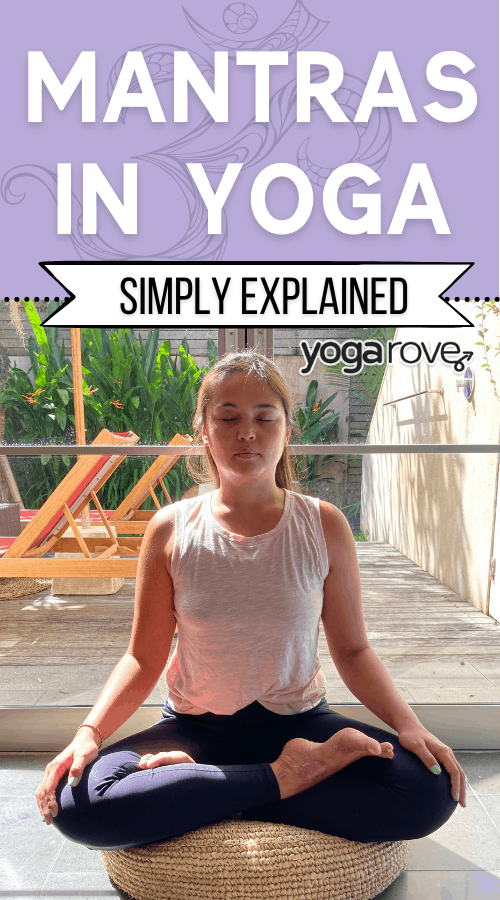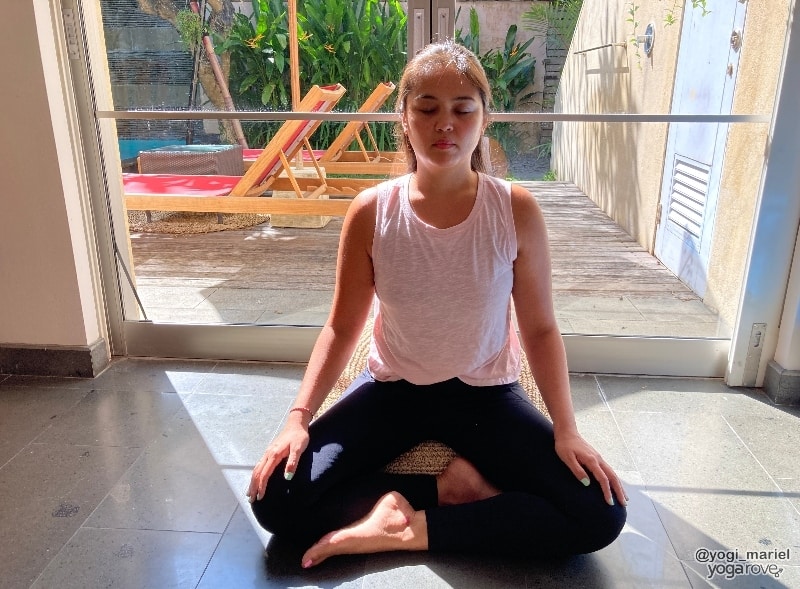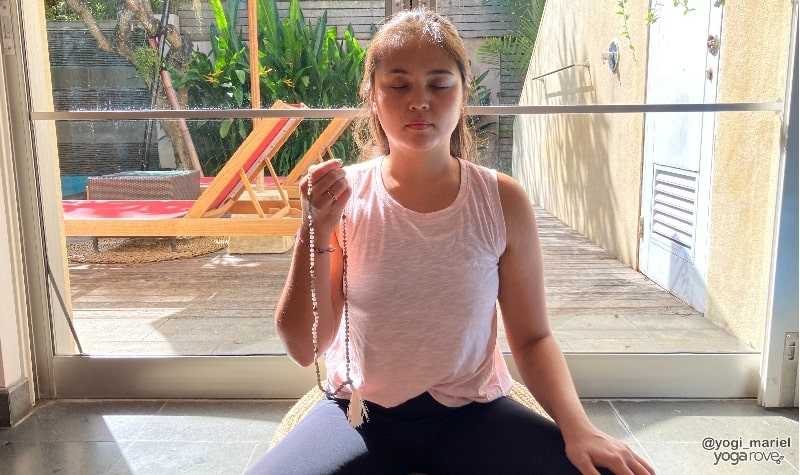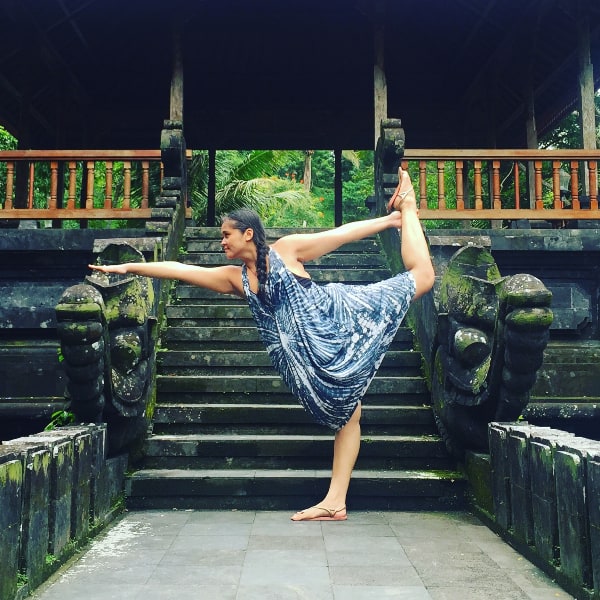This post may contain affiliate links. Please read our disclosure for more info.
When you hear the word ‘mantra’, what is the first image that comes to your mind? Is it a vision of a yogi sitting in lotus position with her mala beads chanting a phrase over and over again? Maybe it’s a large group of yogis repeating the same phrase in a dimly lit yoga room? Many yogis are introduced to mantras from their yoga practice and see the benefits of practicing mantras regularly.

Mantras are powerful sounds, phrases, or words that help to ground and focus the body and the mind. These phrases can be in English or any other language, and often, yogis are introduced to Sanskrit mantras in their meditation or yoga practice. Practicing mantras allow you to cultivate mindfulness and can aid in keeping you present and in the moment.
It can be challenging to slow down your mind and be completely present in the moment. Mantras are a great tool to have and practice because when you chant, speak, or repeat them, they can help to slow down your mind. And when your mind slows down, you are able to:
- Ground and center yourself
- Relax
- Find peace and calm within
What is a Mantra?
You have probably heard of one of the most common and known mantras—‘Om’. Heard in almost every yoga class, this sound or vibration can focus the mind and bring us into the present moment. It can be amazing how one simple sound has so much of a positive effect on your mind and your being.
There is a power to specific sounds, words, or phrases and when repeated. These different sounds, words, or phrases are called mantras and are often seen in meditation and yoga practices.
What is the Purpose of Chanting Mantras?
So why repeat the same phrases over and over again? The practice of repeating certain words with intention can be very powerful and its effects can be felt in the entire body. Mantras can help you to feel:
- Empowered
- Energized
- Focused
- Strong
In yoga and meditation, mantras are often Sanskrit and have their roots in the Hindu tradition. Many mantras invoke certain gods and goddesses and when chanted, they can invoke a certain feeling within. Chanting these mantras out loud or silently carry a certain vibration and energy, and help center and ground the body and the mind.
Are All Mantras in Sanskrit?
Mantras don’t necessarily have to be Sanskrit. You can set a mantra or intention for yourself before your yoga or meditation practice, and it can be something as simple as ‘I am grounded’ or ‘I am letting go’.
The intention behind the mantra can be felt throughout your body, and when practiced or repeated, it can calm the mind and invoke the energy within the mantra. Repeating the mantra focuses the mind and gets rid of external noise or mind chatter. Practicing mantras can be a meditation in itself.
Benefits of Chanting
Repeating and chanting mantras in your practice hold countless benefits. Some of these benefits include:
- Releases endorphins: When you chant, you stimulate the pituitary gland and release feel-good hormones in the body. These endorphins can make you feel lighter, happier, and more grounded in your body, similar to how you may feel after your yoga practice. As you connect to the energy and power of different mantras, your anxiety and fear can start to reduce.
- Triggers the relaxation response: Like a meditation practice, chanting centers and grounds your body and your mind, allowing you to be more relaxed and more present. Your brain and mind slow down, and you are able to be in the present moment without worrying about the future or thinking about the past. You can practice your mantras before you begin your day when you need a moment to recenter, or at the end of a long day.
- Creates a sacred space: A chanting practice can create a space within yourself that is separate from your thoughts or outside stresses. Because chanting brings you into the present moment, you are able to be mindful and grounded in the moment. Like any mindfulness exercise or activity, this takes practice. The more that you practice your mantras and chanting, the easier it will be to create the space for yourself.
Mantras You Can Chant
Below are some of the most well-known and well-loved Sanskrit mantras. You can practice each mantra by repeating it silently or out loud, for a few minutes each day. You can choose which mantra to practice depending on how you feel or what you would like to invoke within yourself.

Om
Om is one of the most recognized mantras. Oftentimes yoga classes may end and begin with the sound of Om. It is widely used in meditation and other mindfulness practices. According to ancient tradition, the sound of Om was the first sound heard during the creation of the universe.
The sound of Om should be practiced by pronouncing each sound completely. Chanting the sound of Om can:
- Allow you to feel energetic vibrations through your entire body
- Open your throat chakra
- Clear away any stagnant energy
Om Shanti, Shanti, Shanti
This mantra translates to ‘Om, peace, peace, peace’. Also widely chanted to open or close yoga practice, this mantra is chanted to invoke peace in yourself and those around you. It also invokes peace in the universe and all of its beings.
Sat Nam
A mantra that is practiced in the Kundalini yoga tradition, amongst others, Sat Nam translates to ‘Truth is my name’. It is a wonderful manta that grounds you in your intuition and your true self. When chanted repeatedly in a meditative state, this mantra can be very powerful and you can feel vibrations in your entire body.
Lokah Samastah Sukhino Bhavantu
A beautiful mantra, Lokah Samastah Sukhino Bhavantu translates roughly to ‘May all beings everywhere be happy and free’. This mantra radiates happiness and a wish for peace to all in the universe. Chant this as a prayer to the universe and all of its inhabitants, or dedicate it to a certain person.
Ong Namo Gurudev Namo
This mantra opens up the communication between the Self and the Divine. It roughly translates to ‘I bow to the creative energy of the infinite. I bow to the Divine channel of wisdom.’ It allows your creative energy and wisdom to blossom and allows you to receive guidance from your own inner teacher.
So Hum
A simple and easy mantra to chant, So Hum means ‘I Am That’. When chanted, it invokes a feeling of oneness, reminding you that we are all one and not separate. This the perfect mantra to practice if you are looking to feel more at one with the universe or to receive love and support from the universe.
Creating a Chanting Practice
It is easy to set up your own chanting or mantra practice right in the comfort of your own home. All you need is yourself, a quiet space, and your voice. Some people choose to use mala beads to keep track of how many times they chant each mantra, but this is not necessary. Here is a step-by-step guide to starting your mantra practice.

Choose a Mantra
You can begin with a simple mantra, like ‘Om’. The more that you learn about the different mantras and what each mantra invokes, you can choose to practice whatever you resonate the most with on each given day.
Set Up a Comfortable Space
You can use the same area in your home that you use for your home yoga practice, or set up a separate space in your home. It is a good idea to keep it quiet and comfortable so that you can settle into your practice.
Find a Comfortable Position
Feel free to use a meditation cushion to sit on as you chant your mantras. Otherwise, you can sit on your couch, yoga mat, or a yoga block. Close your eyes, relax your mind and body, and begin your mantra meditation.
Begin to Chant Your Mantras
You can use mala beads to keep track of how many times you chant each mantra. Each mala has 108 beads, and often this is used during a chanting practice. However, you can chant your mantras without a mala. Simply close your eyes, and repeat the mantra out loud or silently. Choose to practice for a few minutes at first, and then begin to lengthen your practice.
Related Questions
What is Bhakti Yoga? The ‘Yoga of Devotion’, Bhakti yoga is a type of yoga in which one worships the Divine through love and devotion. In Bhakti Yoga, many practice singing and chanting, which is known is ‘Kirtan’, as a way to express devotion to God.
What is Kirtan? Kirtan is the practice of chanting through call and response and music. It is practiced in the Hindu religion and has made its way to the West. Songs and mantras are dedicated to specific Gods, Goddesses, or deities, and are chanted as a way to open the heart and express devotion.
Are Kirtan or Bhakti Yoga religious? Though steeped in Hinduism, one can practice Kirtan and Bhakti Yoga without being Hindu. Participating in a Kirtan gathering does not make you Hindu, and you do not need to be Hindu in order to participate.






